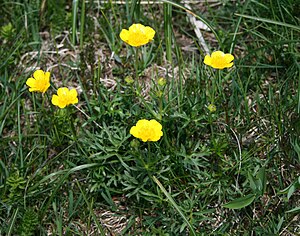Carinthian mountain buttercup
| Carinthian mountain buttercup | ||||||||||||
|---|---|---|---|---|---|---|---|---|---|---|---|---|

Carinthian mountain buttercup ( Ranunculus carinthiacus ) |
||||||||||||
| Systematics | ||||||||||||
|
||||||||||||
| Scientific name | ||||||||||||
| Ranunculus carinthiacus | ||||||||||||
| Hoppe |
The Carinthian mountain buttercup ( Ranunculus carinthiacus ) is a species of plant in the buttercup family (Ranunculaceae). It is common in Europe.
description
The Carinthian mountain buttercup grows as a perennial herbaceous plant and reaches heights of 4 to 20 cm, rarely up to 40 cm. It forms a short and bare rhizome as a permanent organ. The stem with round peduncles is mostly unbranched and mostly adjoining at the bottom, rarely hairy protruding.
The leaves are basal and arranged alternately on the stem. The basal leaves have a glossy, glabrous or only slightly ciliate leaf blade, which is kidney-shaped to five- to seven-sided and divided almost to the base into three or five sections, and is upright when folded; their side sections are in two parts. The stem leaves are small and almost to the base divided into three, five or seven narrow lanceolate sections. These stem leaf sections are six to fifteen times as long as wide and narrowly lanceolate to linear.
The flowering period extends from April to July. On a stem there are only one, rarely two to three flowers above round, pressed down silky hairy flower stalks. The hermaphroditic flowers are radial symmetry. The flower base has tufts of hair at the top or is very hairy. The petal-like nectar leaves are golden yellow and 5 to 15 mm long. The attachment point of the stamens is bare.
The collective fruit contains 25 to 30 nuts. The nuts have a diameter of 20 to 25 mm and a very short beak.
The Carinthian mountain buttercup is diploid with a chromosome number of 2n = 16.
Occurrence
The Carinthian mountain buttercup is common in Europe's mountains. It occurs in northern Spain, in the Pyrenees, the Alps, in the Jura and on the Balkan Peninsula as far as Herzegovina and Bulgaria. In Central Europe it thrives on limestone in subalpine and alpine stone lawns, in Seslerietalia societies, in semi- arid grasslands, and also in societies of the Erico-Pinion or Poion alpinae associations. In the Alps it prefers altitudes between 800 and 2500 m, but descends to 550 m on the Swabian Alb. In the Swabian Alb it thrives in the Gentiano-Brometum of the Mesobromion Association and in the Polygono vivipari-Nestedum sagittalis from the Violion caninae association. In Baden-Württemberg the occurrences are endangered by the eutrophication of semi-arid grasslands; here are the northernmost occurrences within the area.
Systematics
The first description of Ranunculus carinthiacus was made in 1826 by David Heinrich Hoppe in Jakob W. Sturm : Germany's flora in images based on nature with descriptions ... , Department 1, Issue 46, fol. 10. The specific epithet carinthiacus means Carinthian and refers to the fact that this species was first discovered in Carinthia. Synonyms for Ranunculus carinthiacus Hoppe are Ranunculus montanus subsp. carinthiacus (Hoppe) Hegi and Ranunculus montanus var. tenuifolius DC.
swell
- Jürgen Damboldt, Walter Zimmermann: Ranunculaceae. In: Karl Heinz Rechinger, Jürgen Damboldt (Hrsg.): Illustrated flora of Central Europe. Pteridophyta, Spermatophyta . Founded by Gustav Hegi. 2nd, completely revised edition. Volume III. Part 3: Angiospermae: Dicotyledones 1 (Nymphaeaceen, Ceratophyllaceen, Magnoliaceae, Paeoniaceen, Ranunculaceae) . Carl Hanser and Paul Parey, Munich and Berlin / Hamburg 1974, ISBN 3-446-10432-1 , p. 284–285 (published in 1965–1974).
- TG Tutin, JR Akeroyd: Ranunculus. In: TG Tutin, NA Burges, AO Chater, JR Edmondson, VH Heywood, DM Moore, DH Valentine, SM Walters, DA Webb (eds.): Flora Europaea . 2nd, revised edition. Volume 1: Psilotaceae to Platanaceae . Cambridge University Press, Cambridge / New York / Melbourne 1993, ISBN 0-521-41007-X , pp. 275 (English, limited preview in Google Book Search).
- Manfred A. Fischer, Wolfgang Adler, Karl Oswald: Excursion flora for Austria, Liechtenstein and South Tyrol . 2nd, improved and enlarged edition. State of Upper Austria, Biology Center of the Upper Austrian State Museums, Linz 2005, ISBN 3-85474-140-5 .
- Jaakko Jalas, Juha Suominen (ed.): Atlas Florae Europaeae. Distribution of Vascular Plants in Europe. 8. Nymphaeaceae to Ranunculaceae. Akateeminen Kirjakauppa, Helsinki 1989, ISBN 951-9108-07-6 , p. 132.
Individual evidence
- ↑ a b Erich Oberdorfer : Plant-sociological excursion flora for Germany and neighboring areas . With the collaboration of Angelika Schwabe and Theo Müller. 8th, heavily revised and expanded edition. Eugen Ulmer, Stuttgart (Hohenheim) 2001, ISBN 3-8001-3131-5 , pp. 412 .
- ↑ Martin Nebel: Ranunculaceae. In: Oskar Sebald, Siegmund Seybold, Georg Philippi (eds.): The fern and flowering plants of Baden-Württemberg. Volume 1: General Part, Special Part (Pteridophyta, Spermatophyta). 2nd, supplemented edition, Eugen Ulmer, Stuttgart 1993, ISBN 3-8001-3322-9 , pp. 235–322.
Web links
- Carinthian mountain buttercup. In: FloraWeb.de.
- Carinthian mountain buttercup . In: BiolFlor, the database of biological-ecological characteristics of the flora of Germany.
- Profile and distribution map for Bavaria . In: Botanical Information Hub of Bavaria . }
- Ranunculus carinthiacus Hoppe In: Info Flora , the national data and information center for Swiss flora . Retrieved October 20, 2015.
- Thomas Meyer: Data sheet with identification key and photos at Flora-de: Flora von Deutschland (old name of the website: Flowers in Swabia )

